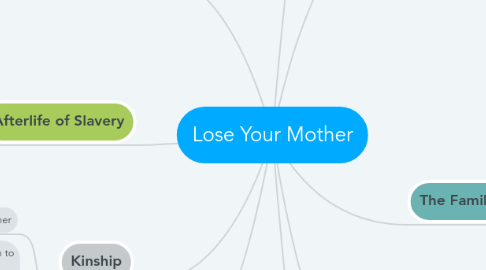Lose Your Mother
by Lele Garner

1. Saidiya Hartman
1.1. Changed name from Valarie
1.1.1. The name change liberated her and established solidarity with the people.
1.1.2. New name - Saidiya means "Helper"
1.2. Traveled to Ghana "in search of strangers" and to find the expendable and the defeated.
1.2.1. Choose Ghana because it possessed more dungeons, prisons and slave pens than any other West African country.
1.2.1.1. Was interested in the memory of slavery. Retrace the slave route.
1.3. slavery is very personal to her. She opens with sharing stories about her family lineage and lack of discussions around slavery.
2. Afterlife of Slavery
2.1. Skewed life chances, limited access to health and education, premature death, incarcerations and impoverishment.
2.2. The black body continues to be in crisis
2.3. Do we find solidarity in other blacks because of our past?
3. Afrotopia
3.1. Meets Mary Ellen and John Ray. An American couple living in Ghana that befriends Saidiya.
3.1.1. Considerations around Black American and "African American. Depends on the belief of heritage and connection. Mary Ellen considered herself "Black American" while Saidiya considered herself still "African American"
3.2. Freedom Trail vs The Nine Major Slave Routes out of Ghana
3.2.1. The slave trade required that a class of expendable people be created. pg.30
3.3. Possibilities of a "Coup"
3.4. Kwame Nkrumah - was a Ghanaian politician and revolutionary. He was the first Prime Minister and President of Ghana, having led the Gold Coast to independence from Britain in 1957
3.5. Alex Haley's "Roots" -It tells the story of Kunta Kinte, an 18th-century African, captured as an adolescent, sold into slavery in Africa, transported to North America; following his life and the lives of his descendants in the United States down to Haley.
4. Markets and Martyrs
4.1. On her second visit to Elmina, she expected to see a site of sadness and despair but instead see's folks that are completely ignoring the fact that they are in a location rich with past slavery.
4.2. Elmina was known for it's thriving trade
4.3. Black Gold - the trading back and forth of slaves for Gold.
4.4. "The Afro-European trade in slaves did not begin in Ghana as it did elsewhere with Africans selling slaves and Europeans buying them. It began with Europeans selling slaves and Africans buying them. " pg. 51
4.5. Portuguese had enslaved and exported nearly half a million Africans by 1600.
5. The Family Romance
5.1. Ghostly Patriarchs
5.2. Branding of slaves - arabic numerals and letters of the alphabet branded onto skin
5.3. Slaves endured examinations of their eyes, genitals, prodded their teeth to assess their overall health and fitness.
5.4. Identifying kin by their cipher from slave trading companies
5.5. The mother's mark and not the fathers name determined your fate.
6. loss that produced the people on the Diaspora
6.1. The most universal definition of the slave is a stranger pg. 5
6.2. Africans didn't sell their brothers and sisters into slavery
6.3. losing your identity, your language, your country, and that's the way they speak of it in West Africa.
6.4. losses that haunt us, those ancestors who we know but can't name. We feel their presence but they're without names for us.
7. Kinship
7.1. Ghanian vs Westerner
7.2. Hartman uses the word Kinship in relation to making a connection between being a African American westerner or an African and the connection to the lineage and the people she interacted with in Ghana.
8. Transatlantic Slave Trade
8.1. involved the transportation by slave traders of enslaved African people, mainly to the Americas.
8.2. The Portuguese, in the 16th century, were the first to engage in the Atlantic slave trade.
8.3. The slave trade regularly used the triangular trade route and its Middle Passage, and existed from the 16th to the 19th centuries.
8.4. The vast majority of those who were enslaved and transported in the transatlantic slave trade were people from Central and West Africa, who had been sold by other West Africans to Western European slave traders (with a small number being captured directly by the slave traders in coastal raids), who brought them to the Americas.
9. Elmina
9.1. A part of Ghana in which at one point was a thriving area known for trade.
9.2. Slavery began with Europeans selling slaves and Africans buying them


